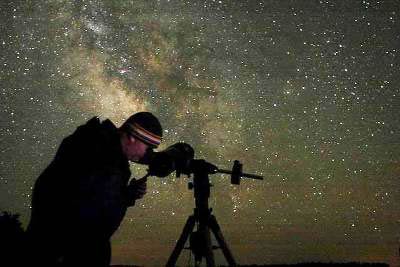
Above our heads every evening is a world of celestial happenings. A telescope can open the night skies for you to enjoy once-in-a-lifetime-events as well as the seasonal meteor showers, eclipses and the beauty of the planets and moon. Here’s what to look for in a telescope.
First rule
When I went shopping for my first telescope I wanted to buy the largest and most expensive one that I could afford. I’m happy I listened to the experts from the Royal Astronomical Society of Canada who recommended starting off small and inexpensive. Not only was the smaller telescope easy to set up and work with, it was also very affordable.
Three types
There are three basic telescope types to choose from:
- Catadioptric: Most expensive and complicated to use.
- Refracting: Most common and is low maintenance.
- Reflector: Less money but requires maintenance.
The amateur astronomer should avoid catadioptric telescopes since they are too expensive and too complicated. Start off with either a refracting or reflector telescope. Each has strengths and weaknesses.
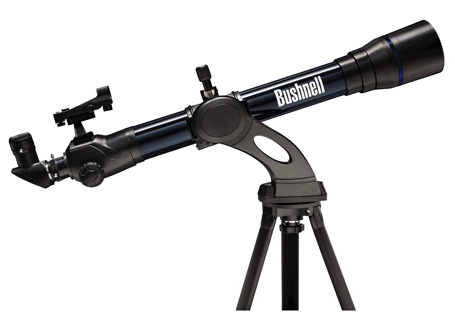 Good enough for Galileo
Good enough for Galileo
The most common type is the refracting telescope, a long, thin tube with a convex objective lens at one end and an eyepiece at the other. It’s the kind Galileo used to discover the rings of Saturn in 1610. Bushnell 700mm Refractor Telescope has an excellent aluminum construction makes it a lightweight but rugged machine easy to transport and set up. Other features that will help with your stargazing are an LED electronic red dot star pointer and Barlow lens and moon filter. Not the best for far away galaxies but you’ll see the details on the moon (including getting a great view of a lunar eclipse) as well as nearby planets, Milky Way and other celestial bodies.

Gathering more light
A reflecting telescope is open on one end and has a primary and secondary mirror. Since mirrors are easier to produce than lenses they tend to be less expensive. The concave primary mirror sends a cone of light up through the tube to the flat secondary mirror that reflects the image to the eyepiece on the side of the tube.
The light and portable Celestron114mm Reflector Telescope can gather more light so it can show those deep star clusters. A computerized hand control also helps you locate the 4,000 celestial objects in its database. Since the tube is open to the air, dust can settle onto the optics so you will need to do some care and maintenance with these types of telescopes.
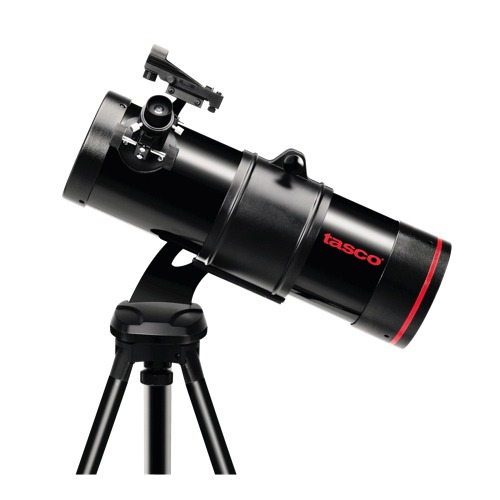
True power
The single most important part of a telescope is its aperture — the adjustable opening that limits the amount of light passing through the lens or mirror. The aperture controls the brightness and sharpness of what you see. The bigger the aperture, the more light the telescope gathers and the better the view. I took this to mean I should buy the biggest size but again I was wrong with that assumption. You shouldn’t be buying your telescope based on aperture alone. You have to consider price, portability and ease of use first and then choose the aperture. Larger lenses or mirrors means a heavier telescope that can be more complicated to use. The Tasco 500mm Reflector Telescope has a 114 mm (4.4 inch) aperture so it strikes a good balance between being portable but still able to grabbing enough light to view the stars. For backyard viewing where you need to compensate for light pollution the Celestron AstroMaster 130EQ Telescope is a better choice. This reflector telescope has a 130 mm (5.11 inch) aperture so it can grab more light but it’s probably a bit too heavy to haul out to less populated and darker areas.
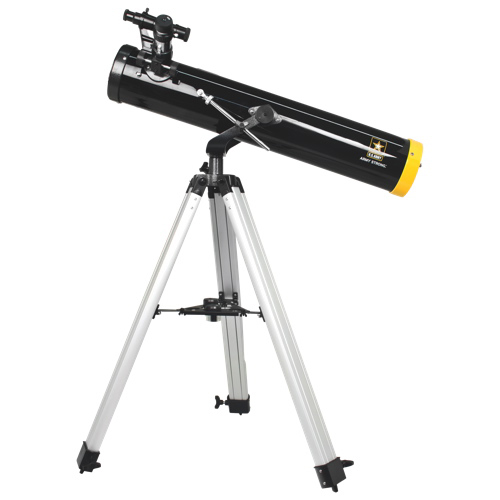 All in the focus
All in the focus
The second most important feature of a telescope is its focal length – that large number you see on the front or back. The longer focus (a higher number) gives better magnification. The same rule as aperture applies: don’t automatically go for the longest, largest telescope out there. It depends on what you want to see.
Choose a long focal length such as the Celestron114mm Reflector Telescope with its 1000 mm (39 inches) focal length for intensely high-powered viewing of a planet or viewing galaxies light years away. High power, longer focal length gives you only a small patch of sky. For more sweeping view, such as the August Pleiades meteor shower, October Orionid or December Geminid meteor showers go for a shorter focal length. The Bushnell with its 700 mm (27 inches) focal length is going to give you a wider view so you’ll see more.
Some telescopes such as the U.S. Army 700×76 Reflector Telescope come with several eyepieces that allow you to change the telescope’s magnification. With eyepieces the smaller numbers indicate a higher magnification. Most beginner telescopes come with a 25mm eyepiece. The US Army telescope comes with three different eyepieces for getting more light for a closer more narrowed view or using less light for a more sweeping view.
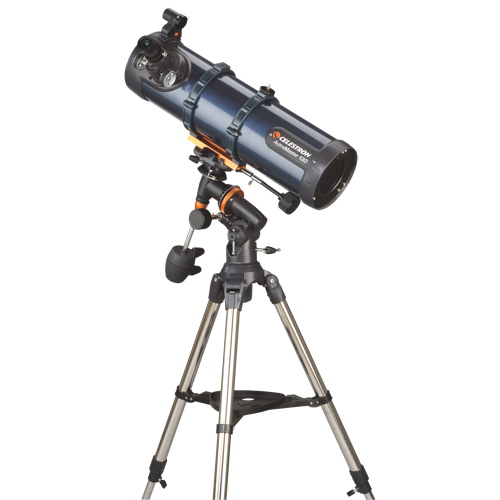 The stable universe
The stable universe
The final consideration is how sturdy the telescope is mounted. It doesn’t matter how large the aperture if you’re looking at a blurry universe through a wobbling telescope There are two basic telescope mounting types. The Altazimuth is similar to a camera tripod: it can be manually adjusted up and down (altitude) or back and forth (azimuth). It’s a stable mount that is both inexpensive and light, allowing you to easily follow stars, moons and planets.
The Celestron114mm Reflector Telescope has a motorized mount for smoother movements and can be used in conjunction with a database.
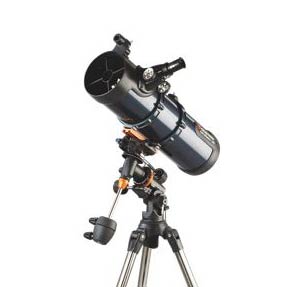
There are two types of equatorial mounts. The classic German equatorial mount is shaped like the letter T. The top part is the polar axis with the telescope on one end and a weight on the opposite end as a counterbalance. It is always aimed towards the North Star to move east and west in order to align with the Earth’s rotation. The delination axis is the middle pole and moves the telescope north and south. Some like the Celestron AstroMaster 130EQ Telescope are manually operated while others can be hooked up to a computer for hands-free viewing.
Fork mounts is one tube with mounts on either side of the telescope. Almost all fork-mounted telescopes are computerized now and mounts are relatively inexpensive. They can also be easily converted into an altazimuth but are not as stable as the German mount.
So to recap: when looking for a telescope consider first what you want to view. For a low maintenance telescope that gives you a sweeping view of our night skies, go with a refracting telescope with a small aperture and short focal length. For pinpointing specific areas on planets or viewing galaxies far, far away go with a higher maintenance reflector telescope with a large aperture and long focal length.
Top Photo by Brian Make Less Noise

Telescopes not your thing but you still want to check out the heavens? Maybe a set of binoculars would suit you.




It’s a very nice and good article.
A very nice and deep article.
Some thoughts…
http://www.bestbuy.ca/en-CA/product/vanguard-vanguard-endeavor-82mm-spotting-scope-hd82a-hd82a/10292154.aspx
A very thoughtful article. I will definitely be going with the higher maintenance reflector now.
Hi xl,
it is better viewing away from the city but if you do want to stay home and view the stars there is a telescope for you. Spotting scope are designed for watching things on earth, in particular birds and ships. While the spotting scopes can be used to view the stars, telescopes don’t really work on land.
Comments are closed.